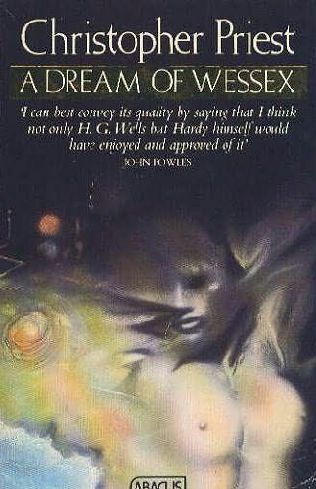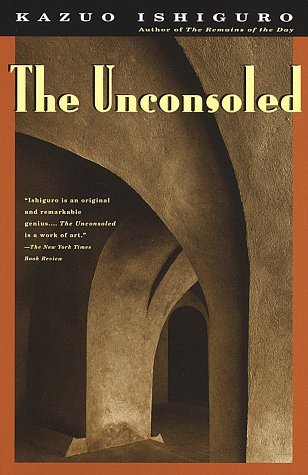October 10, 2008
Methods Of Dreaming

Two novels that – purely by coincidence, or so it would seem – I happened to read one after the other which both draw on dreaming, but which emphasise opposite poles of the dreaming experience.
Christopher Priest's A Dream Of Wessex (1977) is about a collective dreaming project, a government-sponsored initiative to tap the unconscious in order to come up with solutions to the economic and political problems that have paralysed the society in the novel's present day of 1985 . In the projected future world, the USA has converted to Islam and the UK has been annexed by the Soviet Union. The result is a strange kind of utopia, in which the bureaucratic provides a background to the bucolic: the irritations of the Soviet official machinery seem built into the dreamspace as a necessary precondition for the aching languor of the Wessex idyll, where everyday life is suffused by a Mediterranean eroticism. Priest conjures the atmosphere of a gentle solar trance, broken, significantly, by small circular mirrors, which are used to trigger the dreamer's return to the dismal drizzle of the novel's real world.
Once inside the Wessex projection, the participants cannot remember their real world identities. This means that, although they are referred to by the same name, the dreamers in the simulation are different entities from their real world counterparts (just as any dreamer is a different being from their double in waking life). A classic case of the Real (of unconscious wishes) versus reality. When they exit the Wessex simulation, the dreamers are replaced in the consensual hallucination by placeholder doppelgangers, programmed selves that, poossessing no inner life, only exist for the Others in the dreamspace. Some of the participants come to recognise the points at which other dreamers depart from the simulation and come back to it: something in the other, that which is in them more than themselves perhaps, disappears or (seemingly miraculously) returns. What the novel renders especially powerfully is the overwhelming, intoxicating intensity of erotic connections with a dream Other, the uncanny sense of recognition, the deja vu of dreamlove. In the case of A Dream Of Wessex, the sense of recognition between the lovers can be accounted for by the fact that the two, Julia and David, know each in the novel's real world; and yet Julia and David are not in love in the real world, nor is there any suggestion that they would necessarily fall in love. It is their dream-selves that fall for each other. What ultimately unsettles the idyll is the kind of reality bleed or ontological haemorrhage which Priest's later novels all turn around. A Dream Of Wessex looks forward to Gibson's cyberspace, but it is also a vision of the 60s recalled at the bitter end of the 70s.

Kazuo Ishiguro's The Unconsoled (1995) makes contact with another kind of dream space-time altogether. The novel is well-titled since it plunges us, like Alice projected into Wonderland, into a world without consolation, a world of unrelieved urgencies. This is the first and most obvious point of contrast with A Dream Of Wessex, where the official imperatives, both inside and outside the dreamspace, operate as receding pretexts for libidinal trajectories which depart from 'what should be happening' (this tendency puts the whole project at risk). In The Unconsoled, the official, too recedes, but assumes now not the benign quality of the libidinal pretext (the ostensible goal which allows jouissance to happen precisely by being endlessly missed) but the tortuous, tantalising, thwarted object whose failure to be attained casts a pall of terrible anxiety over everything.
Upon arriving in a nameless central European city to give a performance, the renowned pianist Ryder finds himself assailed by countless demands which distract him from his official duties, but which he seems powerless to resist. He must listen to young hopefuls playing the piano; he must speak to late-night meetings of which he was not previously aware; he must go to the outskirts of the city and be photographed in front of a monument whose significance he does not understand. New urgencies are embedded within older urgencies, endlessly.
The Unconsoled is, in part, a pastiche of Kafka, and what Ishiguro borrows from Kafka above all else is his oneiric geography, at once bizarre and strangely familiar. Spaces which had seemed to be very far from another are suddenly revealed to be adjacent; a meeting hall which Ryder has traveled to turns out to be the very hotel that he started from. This allows problems which had seemed intractable to suddenly resolve themselves; yet the solutions bring no relief, for by now Ryder has been gripped by another urgency. The previous imperative, once so overwhelmingly important, recedes into irrelevance at the moment the next one arrives.
In The Unconsoled, as in Kafka, this perverse spatiality of contiguity without consistency arises because all space (and time) is subordinated to the urgency. There is no time except that of the urgency; and all space is curved by the urgency (and its frustrations). Obstacles suddenly emerge: most notably a wall that inexplicably looms up at the last moment preventing Ryder from getting to the concert hall where he is due to give his recital. The hectic pace is driven by the improvisational logic of retrospective confabulation, which is always making sense of things a moment too late. Ryder is perpetually noticing things that should have been obvious. As with Kafka, then, The Unconsoled is coloured by an ingenue's sense of embarrassment.
Two opposed methods of dreaming, then: the one languid, laconic, the other harried, harassed.
Posted by mark at October 10, 2008 12:24 PM | TrackBack